Solar nebula - Study guides, Class notes & Summaries
Looking for the best study guides, study notes and summaries about Solar nebula? On this page you'll find 204 study documents about Solar nebula.
Page 3 out of 204 results
Sort by

-
Oceanography 100 final SDSU Questions and Answers Already Passed
- Exam (elaborations) • 57 pages • 2024
- Available in package deal
-
- $11.99
- + learn more
Oceanography 100 final SDSU Questions and Answers Already Passed How was the solar system formed? -a supernova (explosion of a start when it runs out of fuel) -4.6 billion years ago how was the earth formed? -a nebula made of gas and dust -was formed 4.5 billion years ago how did oceans form? -A volcanic expulsion - rained for thousands of years -hit by an icy comets -volcanic out gassing and ice from comets when did life form? -3.7 billion years ago how long have ani...
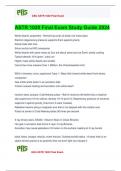
-
ASTR 1020 Final Exam Study Guide 2024
- Exam (elaborations) • 18 pages • 2024
-
- $14.49
- + learn more
White dwarfs: properties - Remaining cores of dead, low mass stars Electron degeneracy pressure supports them against gravity Slowly fade with time Sirius and its hot WD companion White dwarfs with same mass as Sun are about same size as Earth; slowly cooling Typical density 10^6 gram / cubic cm Higher mass white dwarfs are smaller Cannot be more massive than 1.4MSun, the Chandrasekhar limit WDs in binaries: nova, supernova Type I - Mass falls toward white dwarf from binary companion ...

-
SDSU Ocean 100 Final SacramentoGrilo Exam Questions and Answers Graded A 2024
- Exam (elaborations) • 16 pages • 2024
- Available in package deal
-
- $13.49
- + learn more
origin of earth - • Supernova: death of a star (great explosion) • Supernova happened 4.6 bya, dust and gas flattens to a disk and spins faster due to gravity and solar nebula formed. • Solar Nebula: describes formation of Earth 4.5 bya • Nebula: gas cloud origin of oceans - • volcanic explosion, H2O condensed and rained down for thousands of years to create oceans • icy comets hitting earth (responsible for 1/2 of earths ocean water) origin of life - • 4.5 bya ...
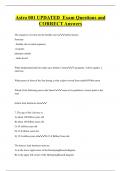
-
Astro 001 UPDATED Exam Questions and CORRECT Answers
- Exam (elaborations) • 20 pages • 2024
-
- $9.49
- + learn more
The sequence of events for the Sunlike star isstellar nursery Protostar , Sunlike star on main sequence, red giant, planetary nebula , white dwarf What fundamental particles make up a helium 3 atom5 up quarks, 4 down quarks, 2 electrons What passes in front of the Sun during a solar eclipse viewed from earththe moon Which of the following moves the fastest?venus at its perihelon ( closest point to the sun)

-
SDSU Ocean 100 Final SacramentoGrilo Exam Questions And Answers 100% Verified
- Exam (elaborations) • 20 pages • 2024
- Available in package deal
-
- $13.49
- + learn more
SDSU Ocean 100 Final SacramentoGrilo Exam Questions And Answers 100% Verified Origin of earth - answer• Supernova: death of a star (great explosion) • Supernova happened 4.6 bya, dust and gas flattens to a disk and spins faster due to gravity and solar nebula formed. • Solar Nebula: describes formation of Earth 4.5 bya • Nebula: gas cloud origin of oceans - answer• volcanic explosion, H2O condensed and rained down for thousands of years to create oceans • icy comets hitting ...

-
billy mitchell aerospace exam questions and answers 100% pass
- Exam (elaborations) • 21 pages • 2024
- Available in package deal
-
- $12.49
- + learn more
billy mitchell aerospace exam questions and answers 100% pass Location of space - Answer- Beyond the influence of earth Micro gravity - Answer- small or low gravity Cislunar space - Answer- the space between the earth and the moon interstellar space - Answer- the distance from one solar system to another interplanetary space - Answer- the space from the center of the sun to the orbit of Pluto galaxy - Answer- an enormous collection of starts arranged in a particular shape universe - Answ...
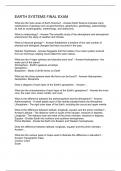
-
EARTH SYSTEMS FINAL EXAM
- Exam (elaborations) • 9 pages • 2024
-
- $12.49
- + learn more
What are the main areas of Earth Science? - Answer-Earth Science includes many subdivisions of geology such as geochemistry, geophysics, geobiology, paleontology, as well as oceanography, meteorology, and astronomy. What is meteorology? - Answer-The scientific study of the atmosphere and atmospheric phenomena' the study of weather and climate. What is historical geology? - Answer-Establishes a timeline of the vast number of physical and biological changes that have occurred in the past. ...
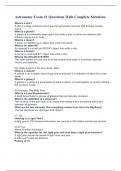
-
Astronomy Exam #1 Questions With Complete Solutions.
- Exam (elaborations) • 10 pages • 2023
-
- $13.49
- + learn more
Astronomy Exam #1 Questions With Complete Solutions. What is a star? A star is a large luminous ball of gas that generates heat and light through nuclear fusion. What is a planet? A planet is a moderately large object that orbits a star. It shines by reflected light. Planets may be icy or rocky What is a moon? A moon (or satellite) is an object that orbits the planet. What is an asteroid? An asteroid is a small and ROCKY object that orbits a star. What is a comet? A comet is small a...
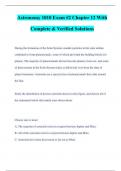
-
Astronomy 1010 Exam #2 Chapter 12 With Complete & Verified Solutions
- Exam (elaborations) • 12 pages • 2023
-
- $11.48
- + learn more
During the formation of the Solar System, smaller particles in the solar nebula combined to form planetesimals, some of which provided the building blocks for planets. The majority of planetesimals did not become planets, however, and some of them remain in the Solar System today as debris left over from the time of planet formation. Asteroids are a special class of planetesimals that orbit around the Sun. Study the distribution of known asteroids shown in this figure, and choose all of t...

-
billy mitchell aerospace exam questions and answers 100% pass
- Exam (elaborations) • 21 pages • 2024
-
- $13.49
- + learn more
billy mitchell aerospace exam questions and answers 100% pass Location of space - Answer- Beyond the influence of earth Micro gravity - Answer- small or low gravity Cislunar space - Answer- the space between the earth and the moon interstellar space - Answer- the distance from one solar system to another interplanetary space - Answer- the space from the center of the sun to the orbit of Pluto galaxy - Answer- an enormous collection of starts arranged in a particular shape universe - Answ...

$6.50 for your textbook summary multiplied by 100 fellow students... Do the math: that's a lot of money! Don't be a thief of your own wallet and start uploading yours now. Discover all about earning on Stuvia


